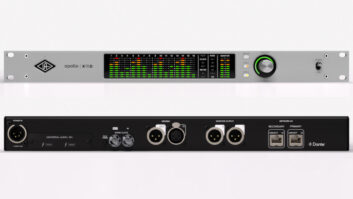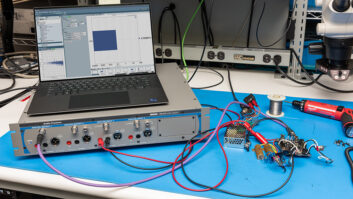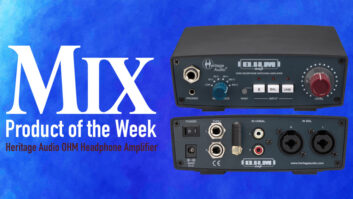
The 2-1176 Dual Limiting Amplifier is a 2-channel version of Universal Audio’s ’60s-era 1176 and uses the same FETs (for gain control elements) and output transformers. The new unit employs metal-film resistors, which produce a lower noise floor than the carbon-film resistors used in the vintage 1176. The 2-1176 also uses rotary switches for ratio and meter functions in lieu of the familiar pushbutton switches for these functions, which appeared on all models of the 1176 (including the reissue in 2000).
AT THE CONTROLS
Each of the 2-1176’s two channels sports continuously variable attack, release, input level and output level controls. Up to 40 dB of total gain is available from the level controls. Attack times range from a blazing fast 20 µs to 800 µs. Release times can be adjusted from 50 ms to 1.1 seconds. A 6-position rotary switch for each channel gives compression ratios of 1:1 (useful when you don’t want compression but would like to use the 2-1176 as a tone device to color a track’s sound), 4:1, 8:1, 12:1, 20:1 and All. The All setting duplicates the compression curve and added distortion produced on a vintage 1176 by pushing in all four ratio pushbuttons simultaneously. Each channel also provides a backlit VU meter and two-position meter function switch; the latter toggles the meter between readouts of gain reduction and output level. In the latter mode, the meters are calibrated to show 0 VU at +4dBm output level.
All rotary controls sport highly visible white hash marks on contrasting black plastic knobs. Values for settings of the attack, release, input level and output level controls are regrettably all represented by arbitrary numbers (vs. µs, ms and decibel values), although extreme settings for time constants are also marked “slow” and “fast,” respectively.

Go to the Focus on Universal Audio page to see video and learn more about UA products.
A single bypass switch deactivates compression on both channels simultaneously. Another switch toggles between dual-mono and stereo-linked operation modes. When stereo-linked, the left channel’s attack and release time settings are also applied to the right channel, but the channel producing the most gain reduction at any given moment also determines the amount of gain reduction for the other channel.
On the 2-1176’s rear panel are balanced XLR I/Os for each channel. These can accommodate unbalanced lines by shunting the pin 3 (cold) signal to pin 1 (ground) on your cable’s connectors. Each channel also sports a rear panel input-impedance switch that offers alternate 600-ohm and 15k-ohm settings; the latter setting produces a sound with more highs and greater depth. The 2-1176’s AC power cord is detachable, and the unit’s internal self-sensing power supply will automatically operate at any voltage ranging from 100 to 240 VAC and at 50 to 60 Hz.
SQUEEZE ME!
The 2-1176 excelled at most applications I threw at it. I routed mults of kick and snare drum tracks to the unit, sharpened their attacks and tightened their decays using the All ratio setting, and then combined the processed outputs with the original tracks to get positively slammin’ drum tracks. The All setting also sounded incredible on drum mic overheads (using the 2-1176’s stereo-link function), producing hyperventilating Led Zeppelin — style tracks.
Set to a 20:1 ratio and fast attack and release settings, the 2-1176 was an outstanding limiter for male vocals, providing a really firm lid without squashing the track’s timbre or pumping. I used the same settings on a rock tune to record electric rhythm guitar played through a Roland Micro Cube amp and using a Royer R-121 ribbon mic and Universal Audio 2-610 tube preamp. The 2-1176 brought intentionally muted bass strings up in level and put a lid on the fully voiced and brighter upper strings, creating a wonderfully chunky, in-your-face — sounding track.
On DI’d electric bass played through a Millennia TD-1, the 2-1176 made the track sound a little choked, even using a 4:1 ratio setting and the slowest possible attack time and with the VU meter showing less than 1dB gain reduction on peaks. You might like the 2-1176 on bass if you’re shooting for a lean sound.
Using the stereo-linked 2-1176 as a stereo bus compressor (with a 4:1 ratio and fast attack) on a rock mix, the image was consistently stable. The trap drum’s attack sounded gloriously slappy and the drum’s decay envelopes were tightened up beautifully. Hard-panned, double-tracked power chords were firmly controlled in the compressed mix, creating a steady level wall of sound. However, I felt that the bass guitar lost a bit of body and sounded somewhat squashed. I could have brought it back to life by backing off on the 2-1176’s attack time, but the drums lost their “spanked” sound. For the best results, I liked compressing stereo subgroups of drums and/or guitars with the 2-1176 and combining the processed output with other elements of the mix at the stereo bus.
A WINNER!
The 2-1176 is one of the best-sounding compressors available. And now that a close reproduction of the venerable 1176 is available in a true stereo/dual-mono configuration, processing stereo subgroups and drum overheads with classic FET compression is easier than ever. Selling for $2,795 list, the 2-1176 gets my highest recommendation.
Universal Audio, 831/466-3737, www.uaudio.com.
Mix contributing editor Michael Cooper is the owner of Michael Cooper Recording, located in beautiful Sisters, Ore. Cooper’s studio offers recording, mixing and mastering services.







